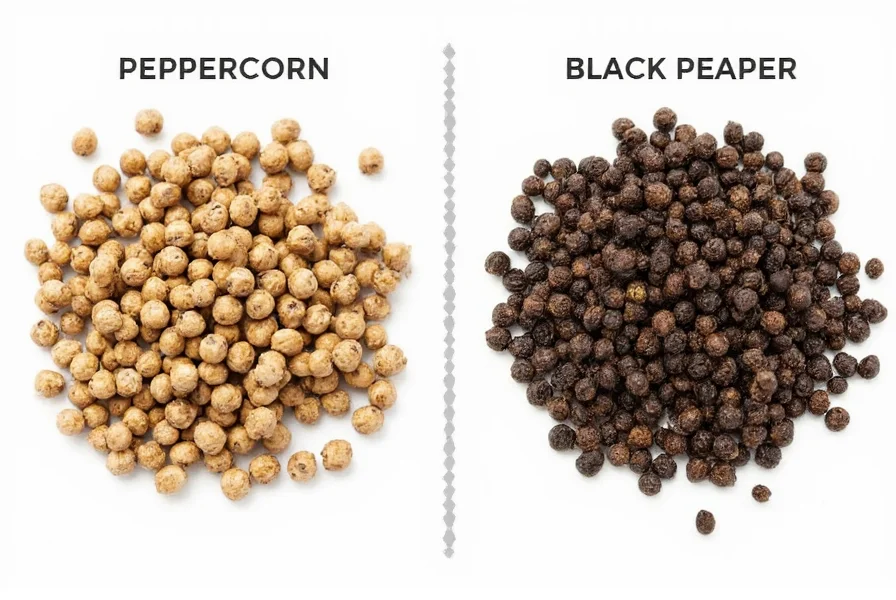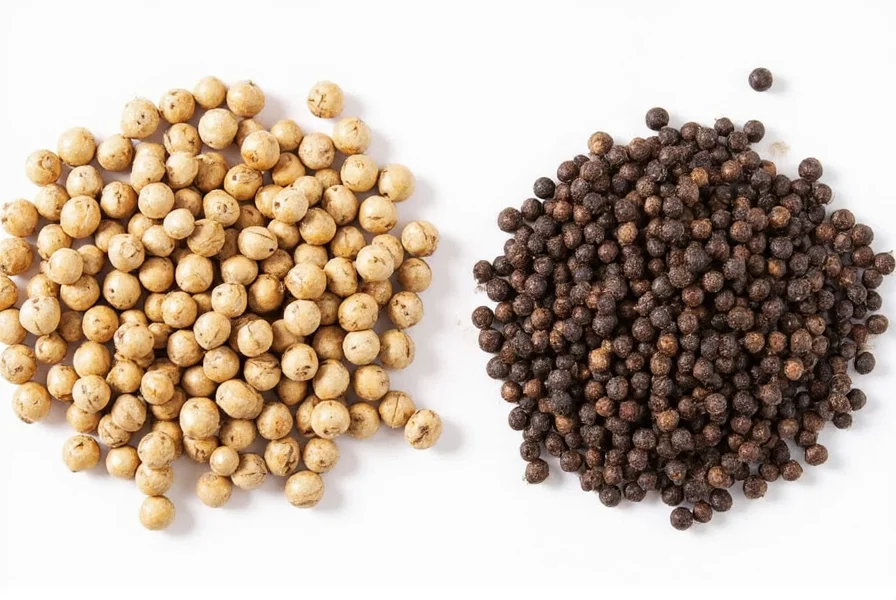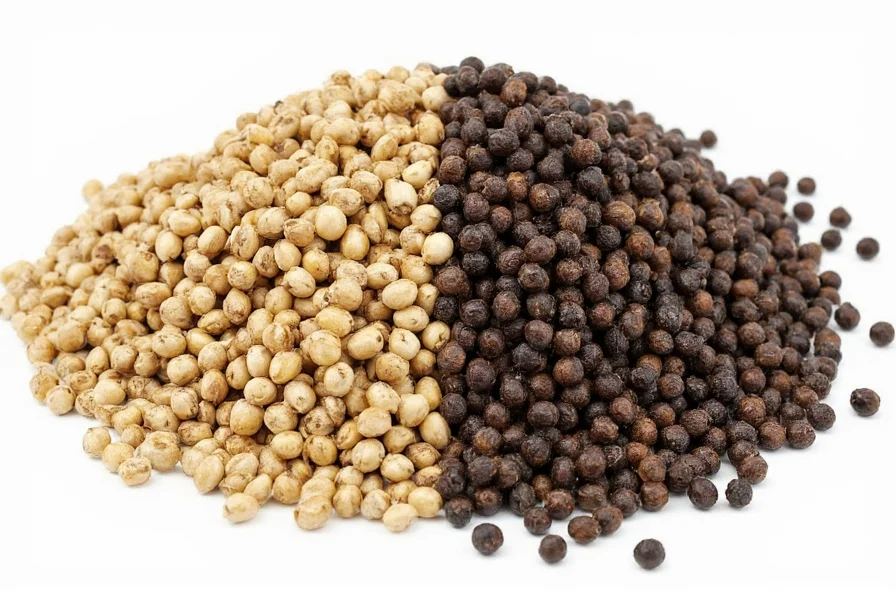Many home cooks and even professional chefs encounter confusion between “peppercorn” and “black pepper.” This misunderstanding stems from inconsistent labeling and culinary terminology. Let's clarify this common kitchen conundrum with botanical accuracy and practical cooking insights.
Understanding the Pepper Plant and Its Fruit
The Piper nigrum vine produces small, green berries that ripen to red. These berries, when harvested and processed, become the peppercorns we use in cooking. The term “peppercorn” specifically refers to the dried fruit of this plant, regardless of color.
What many don't realize is that black pepper begins as green peppercorns. When these unripe green berries are picked and sun-dried, they turn black and wrinkled—becoming what we commonly call “black peppercorns” or simply “black pepper.”
Peppercorn Processing Methods and Results
Different processing techniques create the various pepper varieties found in your spice aisle. The key difference lies in harvest timing and processing:
| Peppercorn Type | Harvest Stage | Processing Method | Flavor Profile |
|---|---|---|---|
| Black Peppercorns | Unripe (green) | Sun-dried until black and wrinkled | Sharp, pungent, complex with floral notes |
| White Peppercorns | Ripe (red) | Soaked to remove outer layer, then dried | Milder, earthier, less complex |
| Green Peppercorns | Unripe (green) | Preserved in brine or freeze-dried | Fresh, herbal, less pungent |
| Red Peppercorns | Ripe (red) | Dried with outer layer intact | Fruity, sweet, floral notes |
Why the Terminology Confusion Exists
The confusion between “peppercorn” and “black pepper” primarily comes from inconsistent usage in recipes, packaging, and culinary contexts. When a recipe calls for “black peppercorns,” it's specifying the whole, unground form. When it says “black pepper,” it typically means the ground version.
Understanding the difference between whole peppercorns vs ground black pepper is crucial for optimal flavor. Whole peppercorns retain their essential oils and pungency much longer than pre-ground pepper, which loses potency rapidly after grinding.
Culinary Applications: When to Use Which Form
Professional chefs emphasize using whole peppercorns whenever possible, then grinding them fresh. This practice maximizes flavor and aroma. Here's when to choose each form:
- Whole peppercorns: Ideal for marinades, pickling, slow-cooked dishes, and when you want distinct pepper flavor pockets
- Freshly ground pepper: Best for finishing dishes, salad dressings, and any application where even distribution matters
- Pref-ground pepper: Acceptable for quick weeknight cooking when convenience outweighs optimal flavor
For those exploring the nuances of peppercorn varieties explained, consider that different pepper types work better with specific cuisines. Black pepper complements robust meats and hearty dishes, while white pepper often appears in light-colored sauces where black specks would be undesirable.
Storage Recommendations for Maximum Freshness
To preserve the volatile oils that give pepper its distinctive flavor, proper storage is essential. Whole peppercorns maintain freshness for 2-3 years when stored in an airtight container away from light and heat. Ground pepper loses significant flavor within 4-6 months.
For home cooks wondering how to use peppercorns in cooking beyond simple grinding, try these techniques:
- Crush peppercorns lightly with a mortar and pestle for steak rubs
- Add whole peppercorns to pickling brines for complex flavor
- Bloom peppercorns in warm oil before adding other ingredients
- Create custom pepper blends by combining different peppercorn varieties

Debunking Common Pepper Myths
Several misconceptions persist about pepper terminology and usage:
- Myth: Black pepper and peppercorns are different spices Fact: Black pepper comes from black peppercorns—they're the same thing
- Myth: All black pepper is created equal Fact: Origin (Vietnam, India, Madagascar) significantly affects flavor profile
- Myth: The spiciness of pepper comes from capsaicin Fact: Pepper's heat comes from piperine, not capsaicin (found in chili peppers)
When shopping for pepper products, understanding the difference between peppercorn and black pepper labeling helps you make informed choices. Premium brands often specify the pepper's origin and harvest method, which directly impacts flavor complexity.

Practical Buying Guide
When selecting pepper products, consider these factors:
- Whole vs. ground: Always choose whole peppercorns when possible for superior flavor
- Origin matters: Tellicherry (India) offers complex notes, Lampong (Indonesia) provides sharp heat, Sarawak (Malaysia) delivers balanced flavor
- Harvest quality: Look for uniform size and absence of dust or broken pieces
- Storage conditions: Buy from retailers with high turnover to ensure freshness
For those exploring the culinary uses of different peppercorns, experimenting with single-origin peppers can reveal surprising flavor variations beyond the standard supermarket offerings.
Frequently Asked Questions
Are peppercorns and black pepper the same thing?
Yes, peppercorns ARE black pepper. Black peppercorns are the dried, unripe fruit of the Piper nigrum plant. The term “peppercorn” refers to the whole berry, while “black pepper” typically describes the ground form, though both terms often refer to the same spice product.
What's the difference between black peppercorns and regular black pepper?
There is no botanical difference—black peppercorns are the whole, dried berries, while “regular black pepper” typically refers to the ground version. The confusion comes from inconsistent labeling. Whole peppercorns retain flavor longer, while ground pepper loses potency quickly after processing.
Can I substitute whole peppercorns for ground black pepper in recipes?
Yes, but with adjustments. As a general rule, 1 teaspoon of whole peppercorns equals approximately 3/4 teaspoon freshly ground pepper. For best results, grind peppercorns fresh when a recipe calls for ground pepper, as pre-ground pepper loses significant flavor and aroma over time.
Why do some recipes specify “black peppercorns” instead of just “black pepper”?
Recipes specify “black peppercorns” when they require the whole, unground form—typically for pickling, marinades, or dishes where distinct pepper flavor pockets are desired. When a recipe says “black pepper,” it usually means freshly ground pepper for even distribution and immediate flavor impact.
Do different colored peppercorns come from different plants?
No, all true peppercorns (black, white, green, red) come from the same Piper nigrum plant. The color difference results from harvest timing and processing methods. Black peppercorns are unripe berries dried in the sun, white are ripe berries with outer layer removed, green are unripe berries preserved, and red are fully ripe berries dried with outer layer intact.











 浙公网安备
33010002000092号
浙公网安备
33010002000092号 浙B2-20120091-4
浙B2-20120091-4